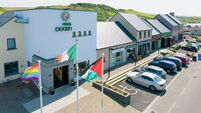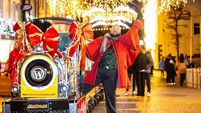Small town America really does exist, in Louisville, Colorado

I love America. There, I said it. It’s no longer popular to admit as much, but I still find its draw irresistible.
I grew up watching Footloose, The Goonies and Dawson’s Creek, and I wanted what they had.
The summer camps and swashbuckling adventures that came with them, school football games that saw the whole town turn out and coke floats served by up by beaming waitresses inside diners bursting with music.
All we had was the chipper.
Most of all, I envied the small town familiarity and friendliness.
I know. Neighbours waltzing through unlocked back doors and lemonade stalls on the front lawn are partly Hollywood fantasies.
It’s a similar sort of nostalgia that leads Americans to believe we spend our days in some sort of Ballykissangel wonderland and the nights hiding from banshees.
Yet wising up and giving up aren’t always the same thing. So 20 years since first tuning into Footloose, I went to see if small town America really exists.
Turns out finding the small town of your dreams isn’t easy. Unassuming and unknown, they aren’t listed in Lonely Planet. Instead, I turned to Google for inspiration.

My search took me through Idaho and Kansas, to the streets of Bar Harbor and Spearfish, but it was Louisville in Colorado that kept putting its hand in the air.
Not for its festivals or foodie credentials, like other towns, but on lists of the best place to raise a family and most livable towns.
It only takes one stroll through town to see why.
Wooden slated pioneer houses sit slumped under snow drifts, bikes lie unlocked on the front lawn and basketball nets wobble on drive ways. The sign outside the school has two words on it, ‘Go Pirates’.
Like most places in Colorado, Louisville started life as a mining town.
The first mine opened in 1877 and by the turn of the century there were more than a dozen, plenty more saloons and accents from Cork, Cologne, and Calabria inside them.
I’m being introduced to the town by Megan and Patty at the Louisville Historical Museum. They tell me how the sense of community kept the town going in the 50s and 60s as the mines failed.
Patty, who grew up in town, talks about skidding around dirt roads on her bike and the old men sat outside playing bocce in a few streets known as Little Italy.
“The town was just a couple of dozen families really,” she says.
I ask her if the town today has that same small town spirit of her childhood.
“Oh, absolutely,” she insists.
“But it has changed.” Megan is nodding. How so, I ask.
“It’s bigger. And times have changed.”
I ask her to elaborate.
“People don’t necessarily want simple lives anymore. When I was in high school, Friday night entertainment was cruising Main Street in a car honking at people we knew. Now there are a dozen restaurants to choose from, live music in the bars and even art galleries.”

She’s right. Not only are there near a dozen restaurants and bars in Louisville but you can even choose from a pair of microbreweries.
And this worries me. I like microbreweries, but they don’t fit with my image of small town America. Nor does the fondue restaurant I stumble across. No one ate fondue in Footloose. I’m worried that it’s all small town show, no spirit.
I go looking for the town’s soul in the The Blue Parrot.
This Italian-American restaurant has been a Louisville fixture since 1919.
The general manager, Joan Colacci Riggins is the granddaughter of the original owner, and her daughter, son and grandchildren also work here.
At the door I’m welcomed with a “hey hun” and told to order the spaghetti. I’m impressed.
My marinara sauce is served in a plastic jug and the spaghetti sits on a formica table.
Not for retro effect, but because that’s the way it comes — unfussy. It’s delicious.
Joan tells me that customers still come in who remember her grandfather, so they don’t change the food or the service too much. As I dig in a head pops through the door and asks,
“Did you see those Broncos?”
“Sure did,” comes the reply from a customer elbow deep in spaghetti at the counter.
“Yep, going pretty well,” he continues, before ducking back out with a “see you next week”.
I’m convinced again. The fondue has been forgiven.

Back out on the street, I glimpse the Rocky Mountains that stretch across the state. I’m here in January, the depths of winter, but even now the peaks are framed by Colorado’s famed big blue sky and warm sun.
It’s this good weather and open space that several people tell me makes Louisville and Colorado so special.
My first adventure into the mountains is proof that Colorado may have 300 days of sunshine, but if you travel 14,000 feet into the sky you’ll find winter has got its act together.
My tour guide is Swiss, and largely unconcerned about things such as blizzards.
I, on the other hand, am certain my ears have blown away in the snow whipping around my head. They haven’t, and as the weather clears the Rockies reveal themselves in all their brutal, but beautiful glory.
The snowcapped mountains roll around the edges of your vision, while the valleys and gulches that wagon trains once braved sink through their centre.
Back in Louisville, everyone has a smile.
The town may have grown to nearly 18,000 souls but life still plays out along a small stretch of Main Street, and in coffee shops like the The Huckleberry and Bob’s Diner, I’m getting a famous welcome.
I’m not just asked where I’m from or what I’m doing, but by my second visit have offers to drive me to mountain towns and invitations to watch football.
I agree to have a go at swinging my legs at a local bluegrass session. Where? The 12 Degree microbrewery.
But it’s in the American Legion I find the warmest welcome. After arriving at the wrong door and announcing myself as being neither ex-military, nor American, I think there’s every chance they’ll march me straight back out.
It’s the other way around. I’m sent to the bar, where I talk Trump and Clinton with Lynn, gun control with Tim and why green beer is never right — yes, even on St Patrick’s Day with everyone else. I’m barely allowed to put my hand in my pocket.

I also meet a Louisville original, Bobby.
The son of immigrants from Italy, Bobby’s time in Louisville was interrupted only by his service in Korea.
He’s come in for his dinner and is perched on the bar sipping on a beer when I interrupt him. I tell him about my small town American dream and ask him whether he thinks Louisville fits the mould?
“Sure,” he says. “I know mostly everyone around and people look out for each other. If you get in a scrape, people will help you out.”
I ask him if he gets into many scrapes these days. He’s shaking his head when Lynn leans across and shows me a video.
It’s Bobby throwing all sorts of shapes on a dance floor. Bobby is pushing 90.
When was this, I ask her. “A few days ago,” she says.
“He still gets into scrapes.”
Small town America is alive, and kicking — literally.
Louisville is about 30 minutes outside Denver. The fastest route is via London with BA; return flights from €700.
Where to stay
Book in at North Main ( www.steelranchliving.com ) apartments at the end of Main Street. They’re modern, spacious and, at $99 a night for a two bedroom apartment, a steal.
The Blue Parrot is a must. But make time for 740 Front as well. With the oldest ongoing tavern licence in Colorado, this former cowboy hangout has been painstakingly restored to its frontier heritage and the carefully sourced steaks are superb.
Come summer or winter it’s all about the Rockies, and Louisville is an excellent base.
Find world class ski trails at Breckenridge or slip on snowshoes to explore Rocky Mountain National Park.
In summer, climb the 14ers (peaks over 14,000 feet) or hike pioneer trails to spot elk, black bears, and eagles soaring overhead.
Aspire Tours ( www.aspire-tours.com ) took me on my adventure into the Rockies Estes Park to see Alpine peaks, but they can also introduce you to Denver’s booming brewing scene or the best independent craft stores along nearby Boulder’s famous Pearl Street Mall.






